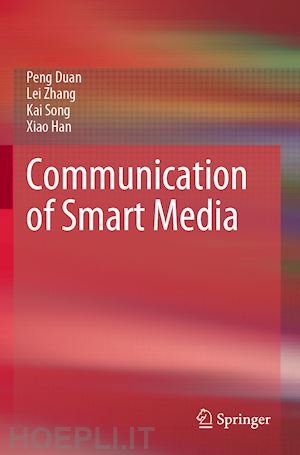Chapter 1 Media’s Role in the AI Era?
1.1 History of human communication
1.1.1 Changes in media over the years
1.1.2 Origin of technology
1.2 What is Smart Media?
1.2.1 Understanding AI
1.2.2 Communication becomes intelligent
1.3 Enter the era of Smart Media communication
Chapter 2 Differences in Smart Media Communication
2.1 New features of Smart Media communication.
2.1.1 All-embracing media, all-inclusive connection
2.1.2 Human-machine interaction, human-machine integration
2.1.3 Public as the participant and public as the media
2.2 New Space & time in Smart Media communication
2.2.1 Time disorder and fragmentation
2.2.2 Space mobility and contextualization
2.3 Smart Media communication myths
2.3.1 Smart Vs Human
2.3.2 Reason Vs Emotion
2.3.3 Virtual Vs Real
2.3.4 Technology Evolution Vs Morality
2.4 New prospects of Smart Media communication
Chapter 3 VR—Pioneering Smart Media Communication
3.1 Definition, features, and history of VR
3.1.1 Definition
3.1.2 History
3.1.3 Features
3.2 Practical application and characteristics of immersive communication
3.2.1 VR + Smart Life
3.2.2 VR + Fashion
3.3.3 VR + Future Images
Chapter 4 SmartStories—The Backbone of Smart Media Communication
4.1 Intelligent Trends in the News Industry
4.2 Changes in news brought by smart technology
4.2.1 Smart News aggregation
4.2.2 Smart News production
4.2.3 Smart News distribution
4.2.4 Smart News consumption
4.3 Reflection and prospects of Smart News
Chapter 5 Social Network—The Core of Smart Media Communication
5.1 Enter the era of social intelligence
5.1.1 From public society to private society
5.1.2 From six degrees of separation to smart society
5.1.3 From interpersonal interaction to human-machine interaction
5.2 Ubiquitous smart communities
5.2.1 Voice as a smart gateway
5.2.2 Ubiquitous smart connection
5.2.3 Beware of social bots
5.3 New social network ecosystem in the smart era
Chapter 6 Platform Society—The Trend of Smart Media Communication
6.1 New smart mechanism of platform society
6.1.1 Digitalization
6.1.2 Commercialization
6.1.3 Selection
6.2 Smart platform ecosystem applications
6.2.1 Smart city and city image communication
6.2.2 Smart healthcare and health communication
6.2.3 Smart education and education communication
6.3 The advent of smart society
Chapter 7 The Push by 5G
7.1 Disruptive communication in the 5G era
7.1.1 From full space and time to full media
7.1.2 From full reality to holographic media
7.1.3 From full connection to all personnel media
7.1.4 From full-featured communication to full-effect media
7.2 Financial media development in the context of 5G intelligence
7.2.1 Refactoring the information system
7.2.2 Reconstructing the user platform
7.2.3 Reshaping the media industry
Chapter 8 Reflection and Future of Smart Media Communication
8.1 The direction of Smart Media
8.2 The future of Smart Media era











